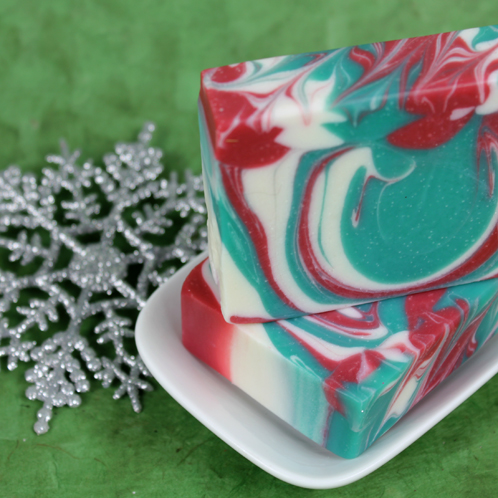 CPOP = Cold Process Oven Process
CPOP = Cold Process Oven Process
Basically, CPOP is forcing a hot, extended gel phase with the help of an oven. Gel phase is temperature phase. After soap is in the mold, the process of saponification can cause the soap to heat up. Gel phase is beneficial to soap because it can intensify colors in the soap.
Professor Kevin M. Dunn, author of Caveman Chemistry and Scientific Soapmaking, mentions that heat and gel phases also speeds along the saponification process. However, not going through gel phase doesn’t detract from soap in any way. In fact, some soapers prefer the matte look of soap that has NOT gelled, or gone through gel phase, and take special steps to prevent gel phase. The warmest part is in the center of the soap (the most insulated section), which is where gel phase starts.
Insulating soap after molding will also promote gel phase, although CPOP will pretty much guarantee a full gel (as opposed to a partial gel, which can appear as a dark ring in the center of your soap). Cooling the soap as quickly as possible will deter gel phase from happening, which is why some soapers put their soap into the fridge or freezer directly after molding. To gel or not to gel is a matter of personal preference, but CPOP is all about the gel phase, baby!
Recipe:
7.5 oz Coconut Oil
7.5 oz Olive Oil
7.5 oz Palm Oil
2.5 oz Sweet Almond Oil
3.4 oz Sodium Hydroxide (Lye)
8.25 oz Distilled Water
1.5 oz Fresh Mango Fragrance Oil
1/2 teaspoon Electric Bubbble Gum Pigment
1 teaspoon Hydrated Green Chrome Oxide
1 teaspoon Titanium Dioxide
2.5 oz Sunflower Oil (or any liquid oil)
1/2 teaspoon Merlot Mica
MOLD PREP: Line the 2 Pound Wood Loaf Mold with Freezer Paper, shiny side up.
COLOR PREP: Disperse the pigments as follows: 1/2 teaspoon Electric Bubble Gum in 1/2 Tablespoon liquid oil, and 1 teaspoon Hydrated Chrome Green Oxide and 1 teaspoon Titanium Dioxide in 1 Tablespoon of liquid oil each. Use a mini mixer to make quick work of the dispersing, but be sure to saturate the powdered pigments in the oil with the tip of the mixer before turning it on (or you’ll wind up with a bit of a mess!).
OVEN PREP: Adjust the racks in the oven so that there is one rack on the lowest notch, and one rack toward the center. Be sure that the central rack isn’t too close to any heating elements. Line the bottom of the oven with foil, or place an old cookie sheet on the bottom rack. Preheat the oven to 170 degrees Fahrenheit (or the lowest setting your oven allows).
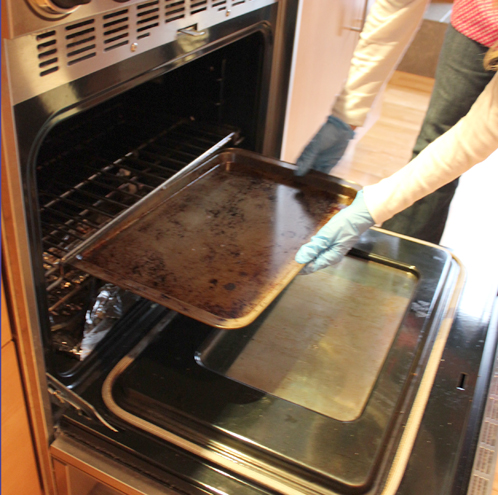
SUIT UP: Before starting this recipe, gear up in gloves, safety goggles (regular eye glasses don’t count!) and long sleeves. Make sure kids and pets are in another part of the house so there are no distractions or tripping hazards. Ensure that there is adequate ventilation in your soaping space to take any fumes away.
ONE: Slowly and carefully add the lye to the water. Stir until clear and set aside to cool.
TWO: Melt and combine the Coconut and Palm Oils. Add the Olive and Sweet Almond oils and mix well.
THREE: Add the lye water to the oils and stick blend until a light trace is achieved.
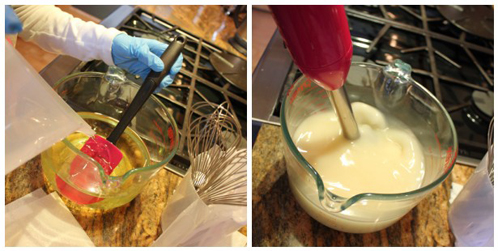
FOUR: Split the batch into three equal parts, about 1.5 cups each. Color one of the batches with 1/2 teaspoon Merlot Mica and 1 teaspoon of dispersed Electric Bubblegum pigment, the second batch with 2 teaspoons dispersed Hydrated Chrome Green oxide, and the third with 3 teaspoons dispersed Titanium Dioxde pigment. Mix each of the colorants in well using a whisk.
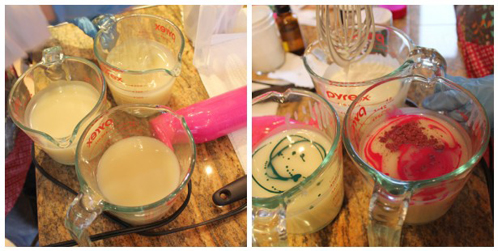
FIVE: Add 0.5 oz Fresh Mango Fragrance Oil to each batch and mix well. Ensure that the soap is at a medium trace before proceeding to the next step; if necessary, use the stick blender.
SIX: Decide on a color order – I went with Red, White, then Green. Slowly pour a bit of the Red soap down the middle of the mold with one back and forth pass. Follow up with the White soap, right down the middle with a back and forth pass. Do the same with a bit of the Green soap. Repeat with all three colors until there is just a little bit left of each.
TIP: As the mold gets fuller and fuller, pour from further and further away, so the soap that’s being poured penetrates all the layers to create the swirl.
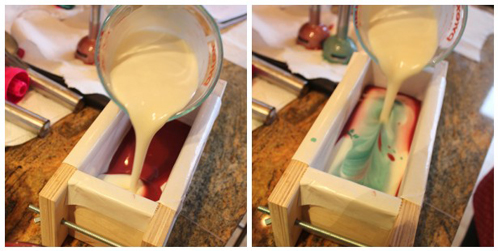
SEVEN: With the last bit of Red, pour a slow and deliberate “U” curve down the length of the mold. Pour close to the mold so the color does not break through layers underneath. Repeat with White, pouring the second “S” shape right next to the Red. Follow with Green, right next to the White.
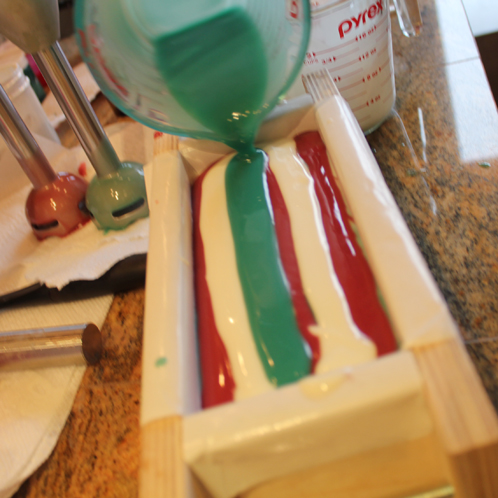
EIGHT: Using a chopstick or dowel stuck into just the first 1/4″ or so of soap, create a swirl by first dragging the chopstick perpendicular to the “U” curves, then horizontally, and finally, diagonally.
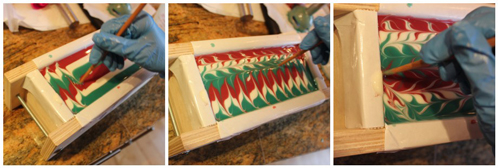
NINE: Stick the soap into an oven, preheated to 170 degrees Fahrenheit, and set the timer for 1 hour. After one hour, turn the oven off, leaving the soap to sit overnight.
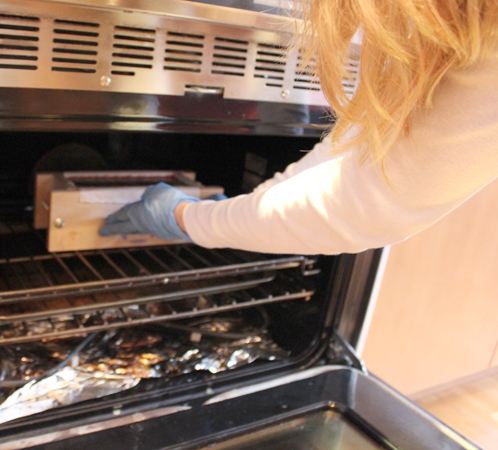
TEN: Pull the soap out of the oven. Allow to sit for another day or two, unmold and cut. In chapter 21 of Scientific Soapmaking, Prof. Dunn notes that the total alkali of raw soap batter is about 10%, and that the total will fall to below 0.1% within an hour if the soap is held at 160 degrees. After unmolding, check the pH of the soap using either pH test strips or the zap test (Prof. Dunn recommends the tongue over the test strip); if it’s all clear, the soap is fine to use! It’s the final bit of pH lowering that happens in the rest of the 4-6 weeks of curing, and the main benefit of the cure time is the evaporation of excess water, which makes for a harder bar and a more true net weight for labeling purposes if you’re selling your soap. So if you’d like a harder bar, allow your soap to go through the usual 4-6 week cure. Enjoy!
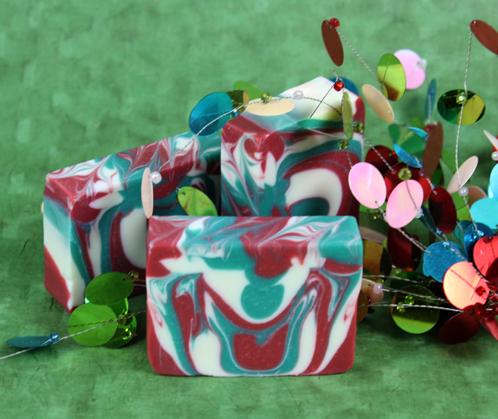
Q: I’ve heard I can use CPOP soap right away, the next day! Is it safe to sell?
A: While technically, the soap is fairly mild within 24 hours, that final 4 weeks of waiting time allows your soap to really hit it’s maximum hardness and long lasting nature. According to Kevin Dunn, “At any realistic temperature, saponification will be complete within 24 hrs.” Using CPOP soap fresh is doing you and your customer a disservice. It is softer and will ‘melt’ in the shower. Give it a 4 week drying period before selling.
Q: I have a plastic mold that I want to use. Can I?
A: No. No you cannot. Traditionally plastic will melt. While technically, you can use silicone that’s rated for baking, like these liners and this awesome silicone loaf mold, there’s an interesting thing that happens with silicone and a super hot gel phase. The soap sort of ‘boils’ on the inside and something about the lack of breathing in silicone makes little air bubble/water bubble pock marks on the entire outside of the loaf. It is more than frustrating to go through the extra work of CPOP, only to find your soap loaf pitted and pocked. The freezer paper gives it breathability that silicone liners or molds don’t give you.
Q: I have a Birchwood molds. Can I use them with CPOP?/ I have a mold that is glued together. Can I use that with CPOP?
A: No. Glue melts in the oven and your mold will fall apart. The Birchwood molds use glue to help keep them together so they are not suitable for CPOP soap.
Q: Can I use any fragrance oil with CPOP? Will they burst into flame if they’re too low of a flashpoint?
A: Yes. No. While you technically can use any soap-safe fragrance oil and essential oil, some of them are quite fleeting and waft or evaporate out when exposed to extremely tough conditions (high pH with cold process soap coupled with a hot, lengthy gel phase). It’s important that you do a small 1 or 2 pound batch and ensure you’re happy with the scent at the 4 week mark after making the soap. Flashpoint is the temperature at which a pure, not mixed or diluted fragrance oil will combust or burst into flames when given an open flame. With CPOP soap, there is no open flame and the fragrance oil has been diluted by over 95% by your soap mixture.
Q: Do I have to do anything special with my recipe to do CPOP?
A: No. You can use your normal cold process recipe. I don’t discount my water with CPOP because so much water evaporates out during the extra hot gel phase process and I worry about the soap cracking but other than that, use your regular cold process soap.
